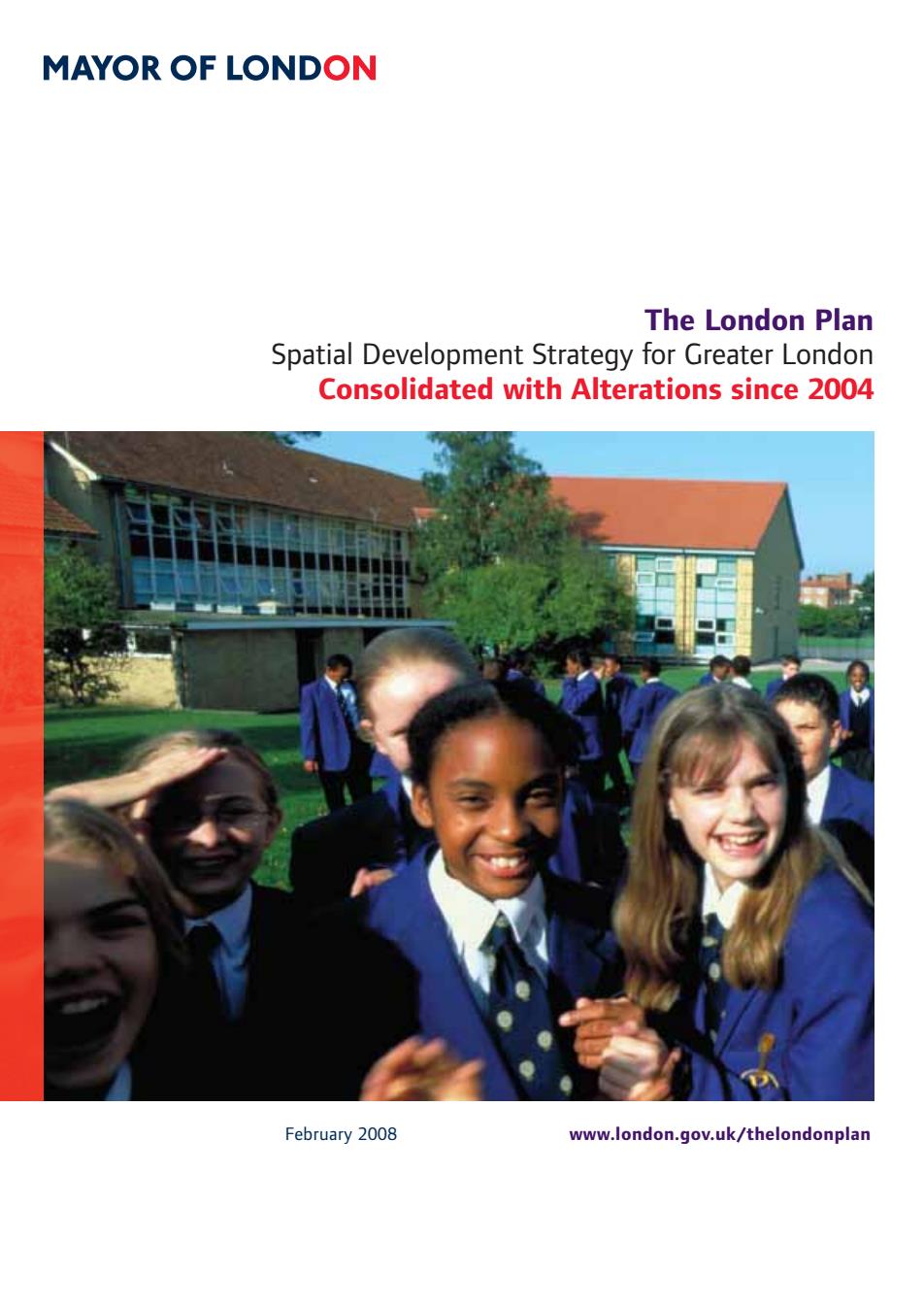
MAYOR OF LONDON The London Plan Spatial Development Strategy for Greater London Consolidated with Alterations since 2004 February 2008 www.london.gov.uk/thelondonplan
February 2008 www.london.gov.uk/thelondonplan The London Plan Spatial Development Strategy for Greater London Consolidated with Alterations since 2004
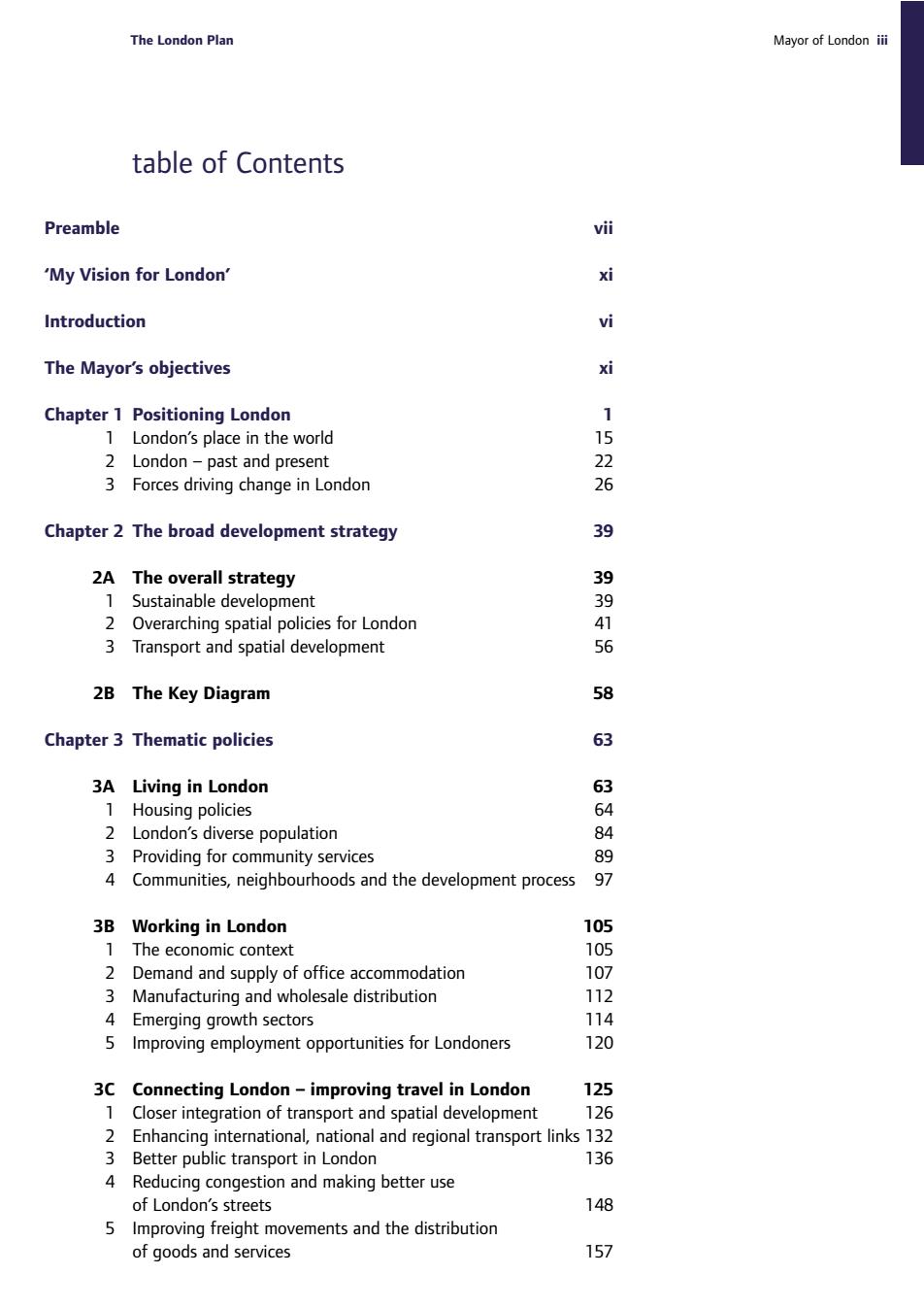
The London Plan Mayor of Londoni table of Contents Preamble vii 'My Vision for London xi Introduction The Mayor's objectives Chapter 1 Positionina London 1 1 London's place in the world 1 past a nd pre sen 3 Forces driving change in Londor 26 Chapter 2 The broad development strategy 39 2A The overall strategy 39 1 Sustainable development 39 2 Overarching spatial policies for London 41 3 Transport and spatial development 2B The Key Diagram 58 Chapter 3 Thematic policies 63 3A Living in London Housing policies 64 2 London's diverse population 3 Providing for community services 4 Communities,neighbourhoods and the development process 9 Working in London 105 The econor ic con 1 Demand d and supply o office accommodation 107 Manufacturing and wholesale distribution 11 4 Emerqing growth sectors 4 5 Improving employment opportunities for Londoners 120 3C Connecting London-improving travel in London 125 1 Closer integration of transport and spatial development 126 2 Enhancing international,national and regional transport links 132 3 better public tra ort in londor 136 A and making better use of Londo 148 Improving freight movements and the distribution of goods and services 157
The London Plan Mayor of London iii Preamble vii ‘My Vision for London’ xi Introduction vi The Mayor’s objectives xi Chapter 1 Positioning London 1 1 London’s place in the world 15 2 London – past and present 22 3 Forces driving change in London 26 Chapter 2 The broad development strategy 39 2A The overall strategy 39 1 Sustainable development 39 2 Overarching spatial policies for London 41 3 Transport and spatial development 56 2B The Key Diagram 58 Chapter 3 Thematic policies 63 3A Living in London 63 1 Housing policies 64 2 London’s diverse population 84 3 Providing for community services 89 4 Communities, neighbourhoods and the development process 97 3B Working in London 105 1 The economic context 105 2 Demand and supply of office accommodation 107 3 Manufacturing and wholesale distribution 112 4 Emerging growth sectors 114 5 Improving employment opportunities for Londoners 120 3C Connecting London – improving travel in London 125 1 Closer integration of transport and spatial development 126 2 Enhancing international, national and regional transport links 132 3 Better public transport in London 136 4 Reducing congestion and making better use of London’s streets 148 5 Improving freight movements and the distribution of goods and services 157 table of Contents
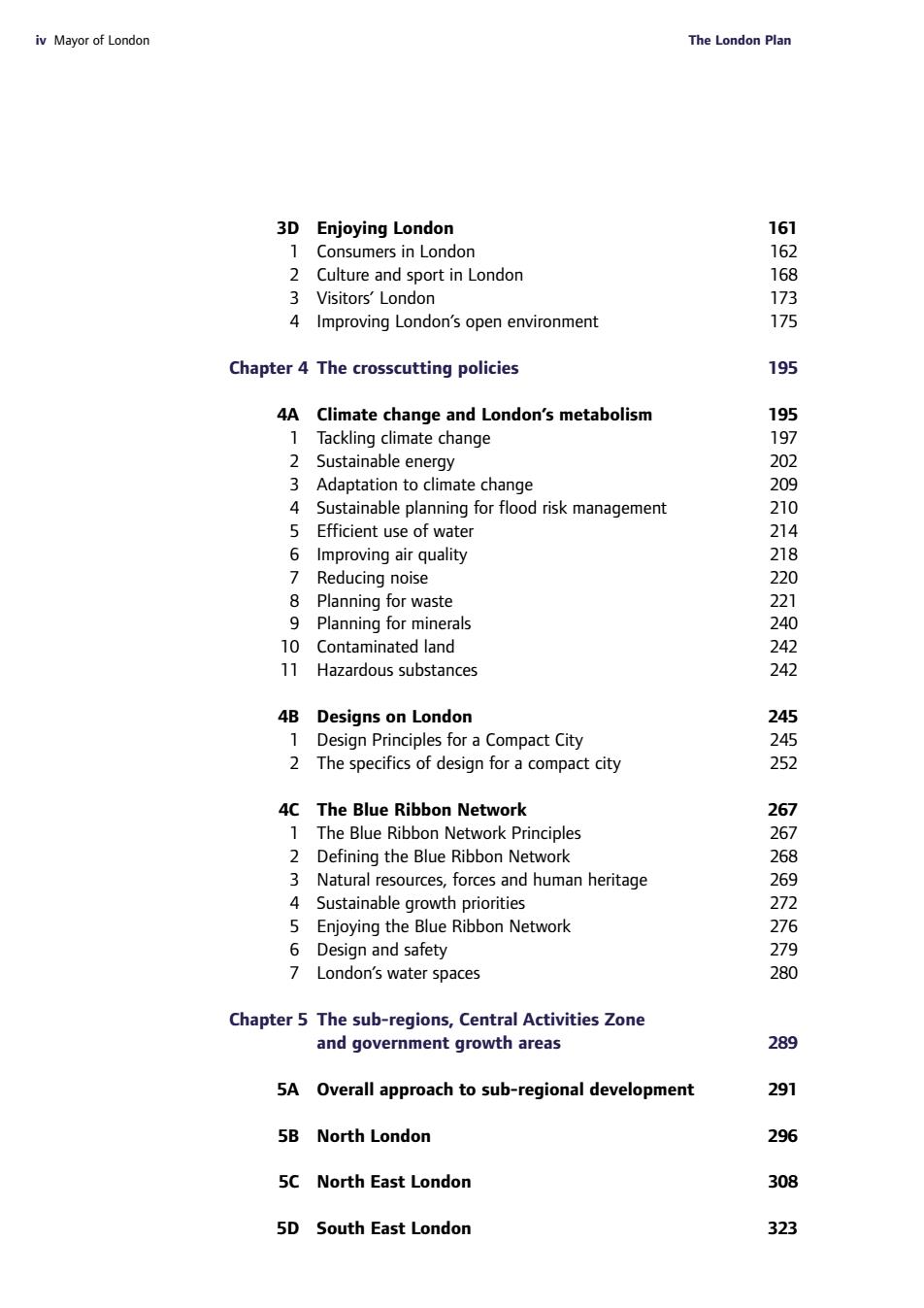
iv Mayor of Londo The London Plar 3D Enjoying Londor Consumers in London 子s0ad。 Culture and sport in London 4 Improving London's open environment 175 Chapter 4 The crosscutting policies 195 4A Climate change and London's metabolism hange 2345 stai Adaptation to climate change 9900 Sustainable planning for flood risk management Efficient use of water 214 6 Improving air quality 218 7 Reducina noise 220 8 Planning for waste 221 9 Planning for minerals 10 Contaminated land 11 Hazardous substa ces 搬 4B Designs on London Design Principles for a Compact City 2 The specifics of design for a compact city 252 4C The Blue Ribbon Network 267 1 The Blue Ribbon Network Principles 267 2 Defining the Blue Ribbon Network 3 Natural resources,forces and human heritage 4 Sustainable 39 56 Enjoying the e Ribbon Networl Design and safety 7 London's water spaces Chapter 5 The sub-regions,Central Activities Zone and government growth areas 8 5A Overall approach to sub-regional development 291 5B North London 296 5C North East London 308 5D South East London 323
iv Mayor of London The London Plan 3D Enjoying London 161 1 Consumers in London 162 2 Culture and sport in London 168 3 Visitors’ London 173 4 Improving London’s open environment 175 Chapter 4 The crosscutting policies 195 4A Climate change and London’s metabolism 195 1 Tackling climate change 197 2 Sustainable energy 202 3 Adaptation to climate change 209 4 Sustainable planning for flood risk management 210 5 Efficient use of water 214 6 Improving air quality 218 7 Reducing noise 220 8 Planning for waste 221 9 Planning for minerals 240 10 Contaminated land 242 11 Hazardous substances 242 4B Designs on London 245 1 Design Principles for a Compact City 245 2 The specifics of design for a compact city 252 4C The Blue Ribbon Network 267 1 The Blue Ribbon Network Principles 267 2 Defining the Blue Ribbon Network 268 3 Natural resources, forces and human heritage 269 4 Sustainable growth priorities 272 5 Enjoying the Blue Ribbon Network 276 6 Design and safety 279 7 London’s water spaces 280 Chapter 5 The sub-regions, Central Activities Zone and government growth areas 289 5A Overall approach to sub-regional development 291 5B North London 296 5C North East London 308 5D South East London 323
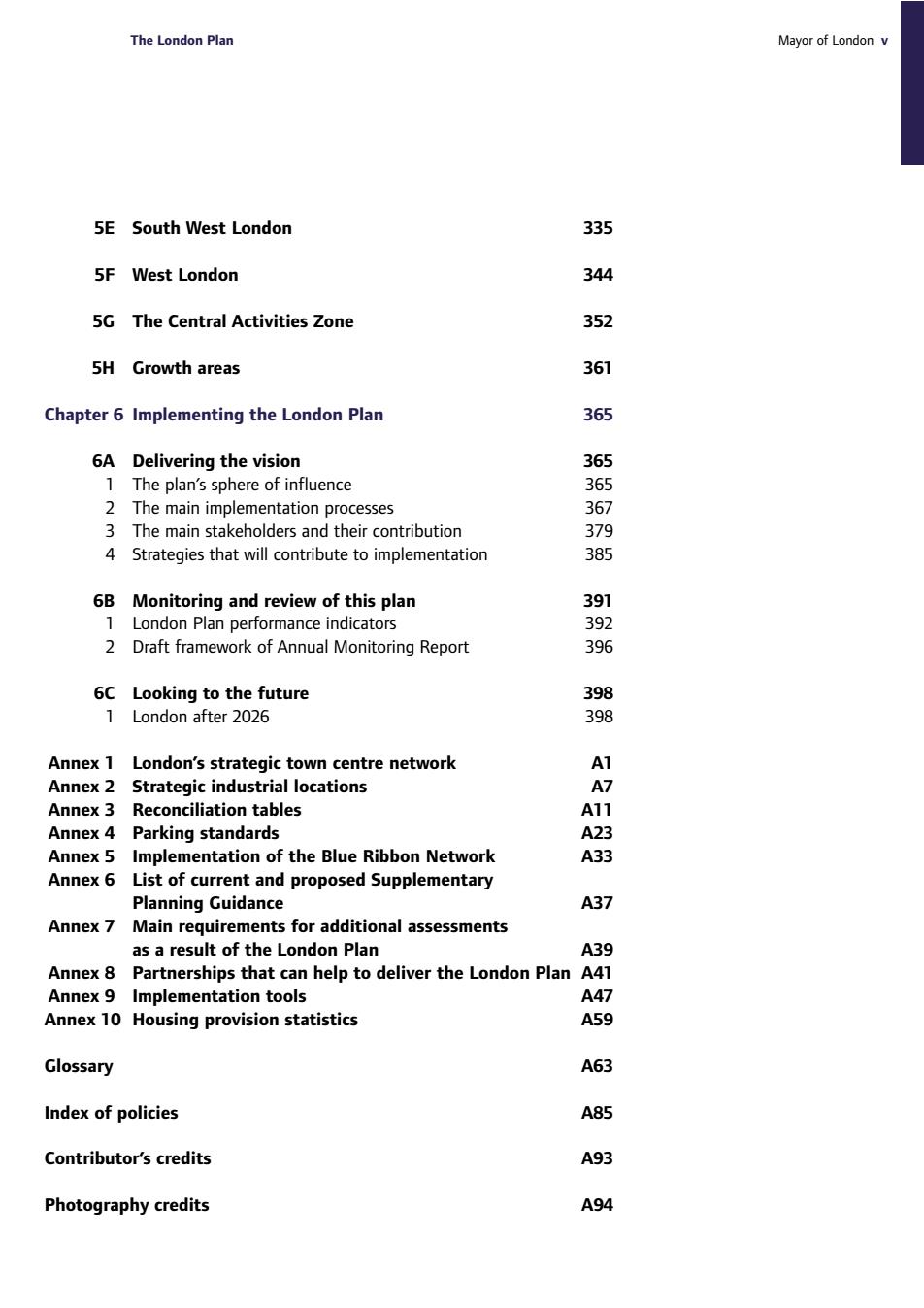
The London Plan Mayor of London 5E South West London 335 5F West Londor 344 5G The Central Activities Zone 352 5H Growth areas 6 Chapter 6 Implementing the London Plan 365 The main implementation processes 3 The main stakeholders and their contribution Strategies that will contribute to implementation 30阳 6B Monitoring and review of this plan 3 1 London Plan performance indicators 9观 2 Draft framework of Annual Monitoring Report 39 6C Looking to the future Londor after 2026 398 Annex 1 London's strategic town centre network Annex 2 Strategic industrial locations Annex 3 Reconciliation tables Annex 4 Parking standards Annex 5 Implementation of the Blue Ribbon Network A Annex 6 List of current and proposed Supplementary Planning Guidance A37 Annex 7 Main ents for additional assessments as a result of the London Plar Annex 8 tnerships that t can help to deliver the London Plan Annex 9 Implementation tools Annex 10 Housing provision statistics Glossary A63 Index of policies A85 Contributor's credits A93 Photography credits A94
The London Plan Mayor of London v 5E South West London 335 5F West London 344 5G The Central Activities Zone 352 5H Growth areas 361 Chapter 6 Implementing the London Plan 365 6A Delivering the vision 365 1 The plan’s sphere of influence 365 2 The main implementation processes 367 3 The main stakeholders and their contribution 379 4 Strategies that will contribute to implementation 385 6B Monitoring and review of this plan 391 1 London Plan performance indicators 392 2 Draft framework of Annual Monitoring Report 396 6C Looking to the future 398 1 London after 2026 398 Annex 1 London’s strategic town centre network A1 Annex 2 Strategic industrial locations A7 Annex 3 Reconciliation tables A11 Annex 4 Parking standards A23 Annex 5 Implementation of the Blue Ribbon Network A33 Annex 6 List of current and proposed Supplementary Planning Guidance A37 Annex 7 Main requirements for additional assessments as a result of the London Plan A39 Annex 8 Partnerships that can help to deliver the London Plan A41 Annex 9 Implementation tools A47 Annex 10 Housing provision statistics A59 Glossary A63 Index of policies A85 Contributor’s credits A93 Photography credits A94
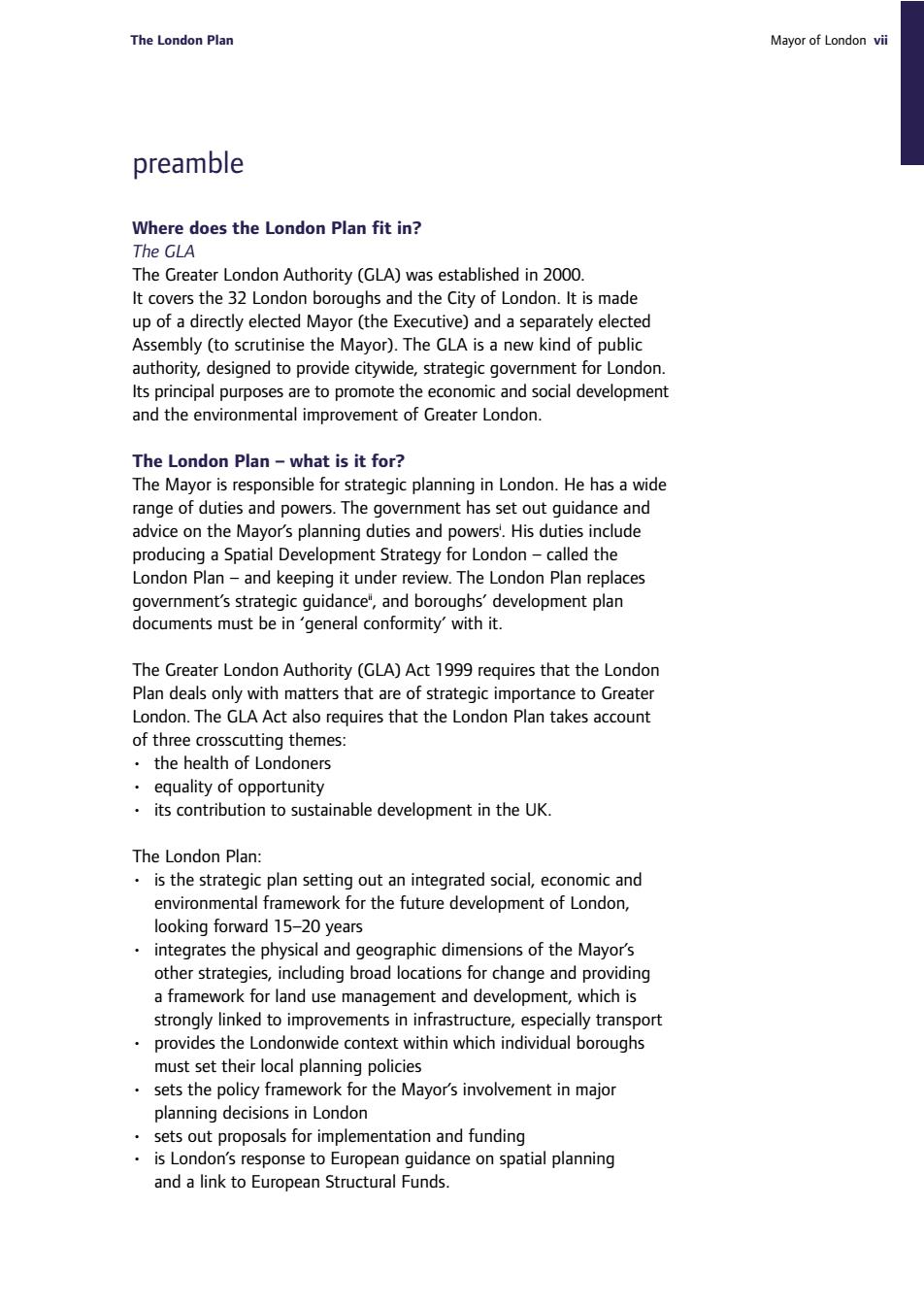
The London Plan Mayor of London vi preamble Where does the London Plan fit in? It covers the 32 London boroughs and the City of London.It is made up of a directly elected Mayor(the Executive)and a separately elected Assembly(to scrutinise the Mayor).The GLA is a new kind of public authority,designed to provide citywide,strategic government for London. Its principal purposes are to promote the economic and social development and the environmental improvement of Greater London. The London Plan -what is it for? advice on the Mayor's planning duties and powers.His duties inc ude producing a Spatial Development Strategy for London-called the London Plan-and keeping it under review.The London Plan replaces government's strategic guidance',and boroughs'development plan documents must be in 'general conformity'with it. The greater london authority (Gla)act 1999 requires that the londor matters that are of strateg mp takes accoun e co ting themes the health of Londoners equality of opportunity its contribution to sustainable development in the UK. The london plan is the strategic plan setting out an integrated social.economic and environmental framework for the future development of London, looking forw vard 15-20 years grates the geo raphic dimensions of the Mayor including broad locations for nge and p t and development,which is strongly linked to improvements in infrastructure,especially transport provides the Londonwide context within which individual boroughs must set their local planning policies sets the policy framework for the Mayor's involvement in major planning decisions in London sets out proposals for implementation and funding is London's esponse to fr uropean idance on spatial planning and a link to rope an Structural F nds
The London Plan Mayor of London vii Where does the London Plan fit in? The GLA The Greater London Authority (GLA) was established in 2000. It covers the 32 London boroughs and the City of London. It is made up of a directly elected Mayor (the Executive) and a separately elected Assembly (to scrutinise the Mayor). The GLA is a new kind of public authority, designed to provide citywide, strategic government for London. Its principal purposes are to promote the economic and social development and the environmental improvement of Greater London. The London Plan – what is it for? The Mayor is responsible for strategic planning in London. He has a wide range of duties and powers. The government has set out guidance and advice on the Mayor’s planning duties and powersi . His duties include producing a Spatial Development Strategy for London – called the London Plan – and keeping it under review. The London Plan replaces government’s strategic guidanceii, and boroughs’ development plan documents must be in ‘general conformity’ with it. The Greater London Authority (GLA) Act 1999 requires that the London Plan deals only with matters that are of strategic importance to Greater London. The GLA Act also requires that the London Plan takes account of three crosscutting themes: • the health of Londoners • equality of opportunity • its contribution to sustainable development in the UK. The London Plan: • is the strategic plan setting out an integrated social, economic and environmental framework for the future development of London, looking forward 15–20 years • integrates the physical and geographic dimensions of the Mayor’s other strategies, including broad locations for change and providing a framework for land use management and development, which is strongly linked to improvements in infrastructure, especially transport • provides the Londonwide context within which individual boroughs must set their local planning policies • sets the policy framework for the Mayor’s involvement in major planning decisions in London • sets out proposals for implementation and funding • is London’s response to European guidance on spatial planning and a link to European Structural Funds. preamble
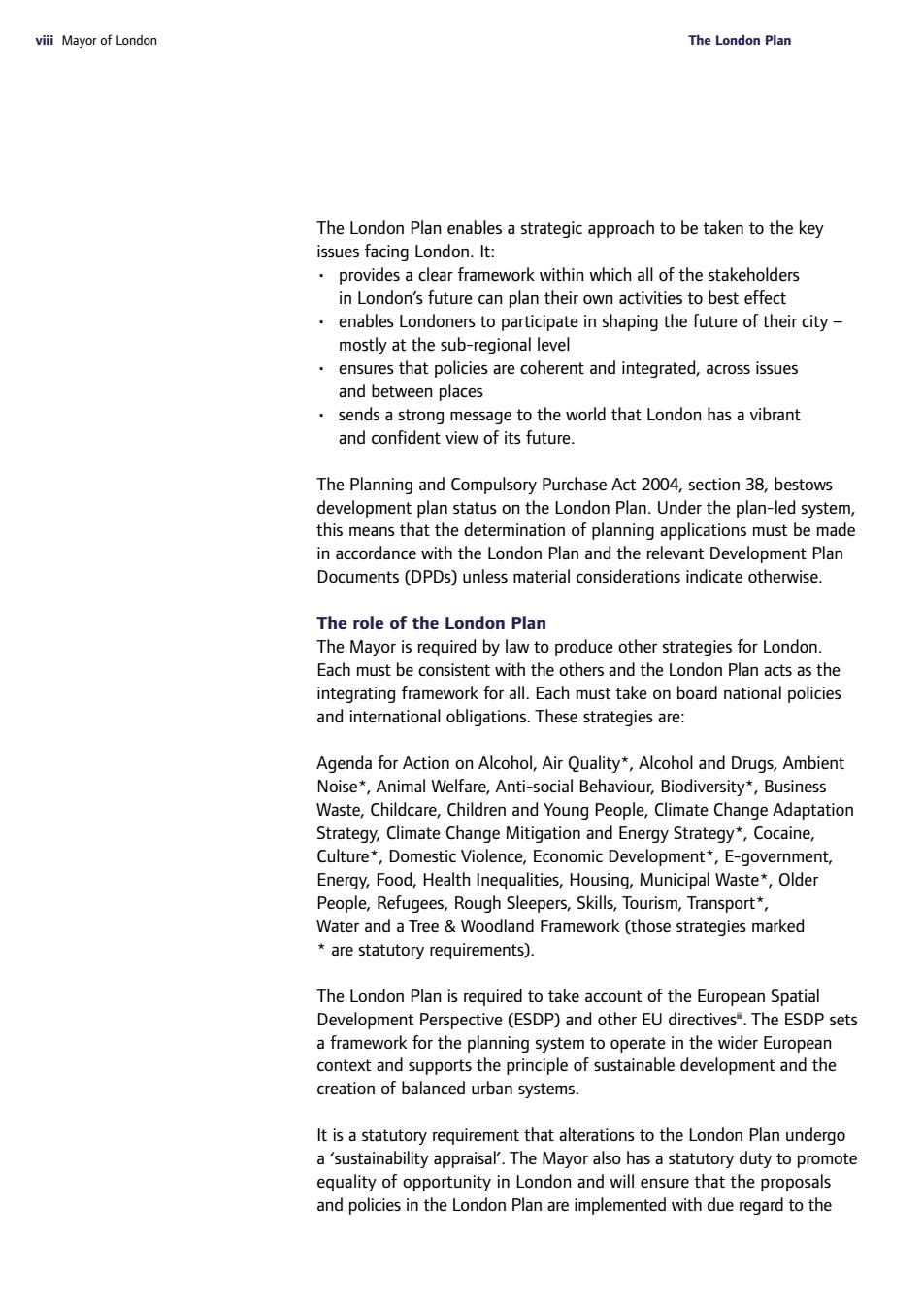
vii Mayor of London The London Plar The London Plan enables a strategic approach to be taken to the key issues facing London.It: provides a clear framework within which all of the stakeholders in London's future can plan their own activities to best effect enables Londoners to participate in shaping the future of their city mostly at the sub-regional level ensures that policies are coherent and integrated.across issues and between places sends a strong message to the world that London has a vibrant and confident view of its future The Planning and Compulsory Purchase Act 2004,section 38,bestows development plan status on the London Plan.Under the plan-led system, this means that the determination of planning applications must be made in accordance with the London Plan and the relevant Development Plan Documents(DPDs)unless material considerations indicate otherwise. The role of the London Plan The Mayor is required by law to produce other strategies for London Each must be nsistent with the othe and the london plar acts asth integrating ork for all.Ea ach must take e on boar national policie and international obligations.These strategies are Agenda for Action on Alcohol,Air Quality",Alcohol and Drugs,Ambient Noise,Animal Welfare,Anti-social Behaviour,Biodiversity,Business Waste,Childcare,Children and Young People,Climate Change Adaptation Strategy,Climate Change Mitigation and Energy Strategy*,Cocaine, Culture*.Domestic Violence,Economic Development*,E-government, Energy,Food,Health Inequalities,Housing,Municipal Waste*Older People.Refuo Skills Tou ism Tra Wate and a Framework (thos e strategies marked are statutory requirements) The London Plan is required to take account of the European Spatial Development Perspective (ESDP)and other EU directives".The ESDP sets a framework for the planning system to operate in the wider European context and supports the principle of sustainable development and the creation of balanced urban systems. astatutory requirement that atertions to theond Pan appraisal.The Mayo also has a statutory duty to pr opp ortunity in Londo and will e e th the propos and policies in the London Plan are implemented with due regard to the
viii Mayor of London The London Plan The London Plan enables a strategic approach to be taken to the key issues facing London. It: • provides a clear framework within which all of the stakeholders in London’s future can plan their own activities to best effect • enables Londoners to participate in shaping the future of their city – mostly at the sub-regional level • ensures that policies are coherent and integrated, across issues and between places • sends a strong message to the world that London has a vibrant and confident view of its future. The Planning and Compulsory Purchase Act 2004, section 38, bestows development plan status on the London Plan. Under the plan-led system, this means that the determination of planning applications must be made in accordance with the London Plan and the relevant Development Plan Documents (DPDs) unless material considerations indicate otherwise. The role of the London Plan The Mayor is required by law to produce other strategies for London. Each must be consistent with the others and the London Plan acts as the integrating framework for all. Each must take on board national policies and international obligations. These strategies are: Agenda for Action on Alcohol, Air Quality*, Alcohol and Drugs, Ambient Noise*, Animal Welfare, Anti-social Behaviour, Biodiversity*, Business Waste, Childcare, Children and Young People, Climate Change Adaptation Strategy, Climate Change Mitigation and Energy Strategy*, Cocaine, Culture*, Domestic Violence, Economic Development*, E-government, Energy, Food, Health Inequalities, Housing, Municipal Waste*, Older People, Refugees, Rough Sleepers, Skills, Tourism, Transport*, Water and a Tree & Woodland Framework (those strategies marked * are statutory requirements). The London Plan is required to take account of the European Spatial Development Perspective (ESDP) and other EU directivesiii. The ESDP sets a framework for the planning system to operate in the wider European context and supports the principle of sustainable development and the creation of balanced urban systems. It is a statutory requirement that alterations to the London Plan undergo a ‘sustainability appraisal’. The Mayor also has a statutory duty to promote equality of opportunity in London and will ensure that the proposals and policies in the London Plan are implemented with due regard to the

The London Plan Mayor of London ix Amendment Act 2000,the Disability Disc mination Acts 5ad ther relevant overment policy advice The London Plan has accordingly been formulated having had regard to the matters specified in sections 41 and 342(1)(a)of the Greater London Authority Act 1999 and Regulation 6(1)of the Town and Country Planning (London Spatial Development Strategy)Regulations 2000, to all relevant EU directives and UK legislation,and to Government advice and regional planning guidance.The London Plan is subject to an ongoing epstTPubishedamay itoring and managing change and a monitoring The plan takes the year 2025/26 a of the targets and statistics relate to earlier years(especially 2016) because information is more readily available and/or reliable for those dates.Preparation of Alterations has been informed by a parallel scenario development and policy testing exercise". References Department of Transport,Local Government and the Regions. Planning:De SegetoigefrlontcSCrtaionDatcaLaauh Government Office for London.RPG3 Regional Planning Guidance:Strategic Planning trategic Planning Guidance for the River Thames GOl 1997 WCytn0ppe9aph2a
The London Plan Mayor of London ix Race Relations Amendment Act 2000, the Disability Discrimination Acts 1995 and 2005 and other relevant government policy advice. The London Plan has accordingly been formulated having had regard to the matters specified in sections 41 and 342 (1)(a) of the Greater London Authority Act 1999 and Regulation 6(1) of the Town and Country Planning (London Spatial Development Strategy) Regulations 2000, to all relevant EU directives and UK legislation, and to Government advice and regional planning guidance. The London Plan is subject to an ongoing process of monitoring and managing change and a monitoring report is published annually. The plan takes the year 2025/26 as its formal end date because the Mayor believes a long-term view of London’s future is needed. Many of the targets and statistics relate to earlier years (especially 2016) because information is more readily available and/or reliable for those dates. Preparation of Alterations has been informed by a parallel scenario development and policy testing exerciseiv . References i Department of Transport, Local Government and the Regions. Planning: Delivering a fundamental change. HMSO, 2001 Government Office for London. Circular 1/2000. Strategic Planning in London. DETR, 2000 Government Office for London. Consultation Draft GoL Circular. Strategic Planning in London, GOL, 2008 ii Government Office for London. RPG 3 Regional Planning Guidance: Strategic Planning Guidance for London Planning Authorities. HMSO 1996 Government Office for London. RPG3b: Strategic Planning Guidance for the River Thames GOL, 1997 iii GoL Circular 1/2000 op cit, paragraph 2.8 iv Berkeley Hanover Consulting, BWA, Michael Ling. Further Alterations to the London Plan: Scenario Development and Policy Testing Project. GLA, 2006
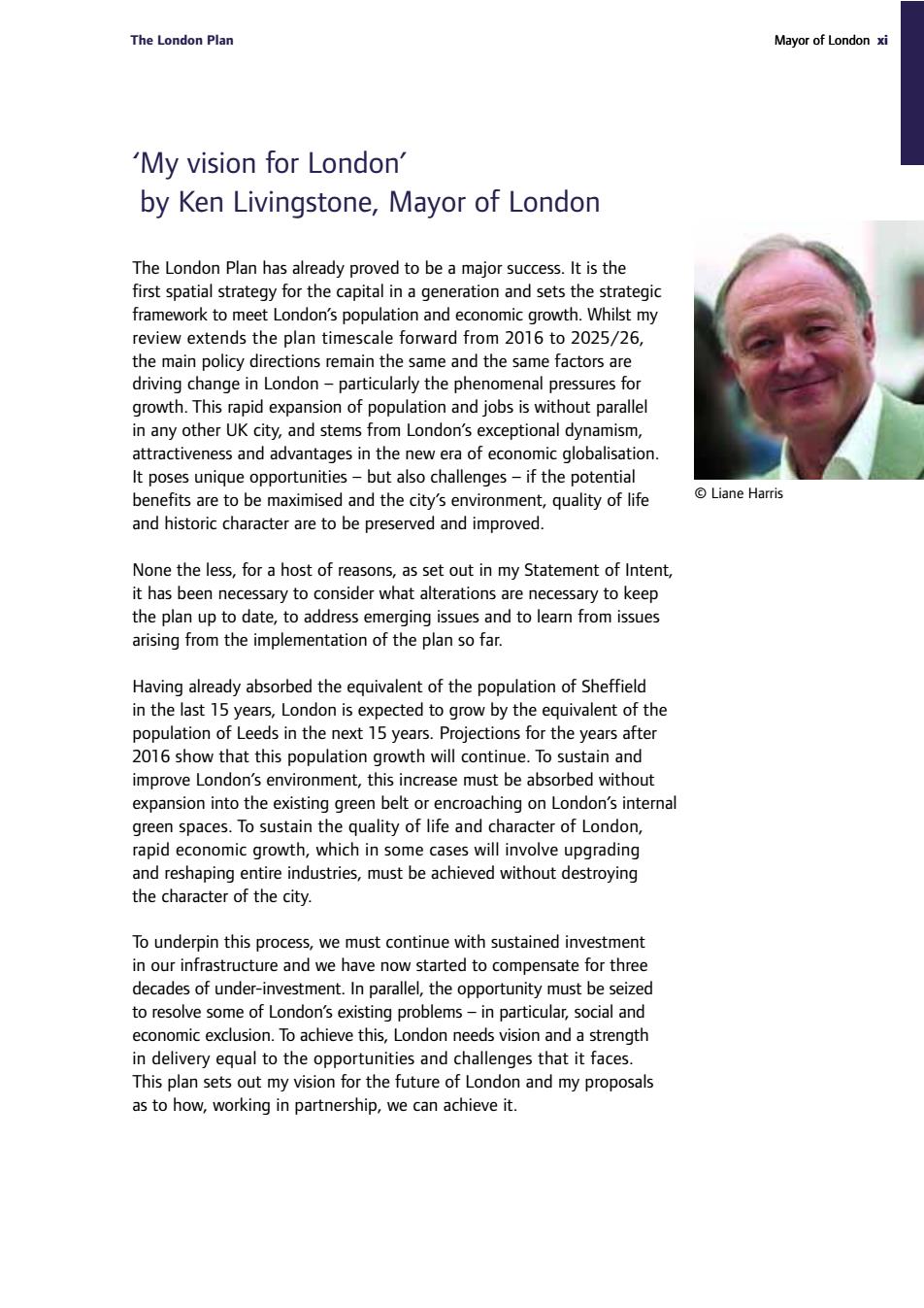
The London Plan Mayor of London xi 'My vision for London' by Ken Livingstone,Mayor of London The London Plan has already proved to be a major success.It is the first spatial strategy for the capital in a generation and sets the strategic framework to meet london's population and economic arowth.whilst my review extends the plan timescale forward from 2016 to 2025/26 ma npolicydire ns remain the nd the actors nge i partic y the pl nnother UK citnrom ondom id tion and jobs is wit attractiveness and advantages in the new era of economic globalisation. It poses unique opportunities-but also challenges-if the potential benefits are to be maximised and the city's environment,quality of life liane harri and historic character are to be preserved and improved. None the less,for a host of reasons,as set out in my Statement of Intent, it has been nec ider what alterati the plar up to date nd to learn fi Having already absorbed the equivalent of the population of Sheffield in the last 15 years,London is expected to grow by the equivalent of the population of Leeds in the next 15 years.Projections for the years after 2016 show that this population growth will continue.To sustain and improve London's environment.this increase must be absorbed without expansion into the existing green belt or encroaching on London's internal the y and char acter of ondon wth,whic h in will inv upgra en re industries,must be achieved without destroying To underpin this process,we must continue with sustained investment in our infrastructure and we have now started to compensate for three decades of under-investment.in parallel.the opportunity must be seized to resolve some of london's existina problems-in particular social and economic exclusion.To achieve this,London needs vision and a strength in delivery equal to the opportunities and challenges that it face This for the future of londo and my proposals as to how,working in partnership,we can achieve it
The London Plan Mayor of London xi The London Plan has already proved to be a major success. It is the first spatial strategy for the capital in a generation and sets the strategic framework to meet London’s population and economic growth. Whilst my review extends the plan timescale forward from 2016 to 2025/26, the main policy directions remain the same and the same factors are driving change in London – particularly the phenomenal pressures for growth. This rapid expansion of population and jobs is without parallel in any other UK city, and stems from London’s exceptional dynamism, attractiveness and advantages in the new era of economic globalisation. It poses unique opportunities – but also challenges – if the potential benefits are to be maximised and the city’s environment, quality of life and historic character are to be preserved and improved. None the less, for a host of reasons, as set out in my Statement of Intent, it has been necessary to consider what alterations are necessary to keep the plan up to date, to address emerging issues and to learn from issues arising from the implementation of the plan so far. Having already absorbed the equivalent of the population of Sheffield in the last 15 years, London is expected to grow by the equivalent of the population of Leeds in the next 15 years. Projections for the years after 2016 show that this population growth will continue. To sustain and improve London’s environment, this increase must be absorbed without expansion into the existing green belt or encroaching on London’s internal green spaces. To sustain the quality of life and character of London, rapid economic growth, which in some cases will involve upgrading and reshaping entire industries, must be achieved without destroying the character of the city. To underpin this process, we must continue with sustained investment in our infrastructure and we have now started to compensate for three decades of under-investment. In parallel, the opportunity must be seized to resolve some of London’s existing problems – in particular, social and economic exclusion. To achieve this, London needs vision and a strength in delivery equal to the opportunities and challenges that it faces. This plan sets out my vision for the future of London and my proposals as to how, working in partnership, we can achieve it. ‘My vision for London’ by Ken Livingstone, Mayor of London © Liane Harris

xi Mayor of London The London Plar strong,diverse long term economic growth social inclusivity to give all Londoners the opportunity to share in London's future success fundamental improvements in London's environment and use of resources. This vision seeks to achieve the maximum possible from the forces to which the ssubject and The London Plan provides the unified,spatial framework for all my strategies and is designed to ensure that Londoners benefit from sustainable improvements to their quality of life.These strategies collectively show how that can be done-based on a shared vision, robust policies.a commitment to partnership between the public. ontetorndaddtionresources The most substantial changes I have made to the London Plan relate to tackling climate change.If the world does not take rapid and sustained action to reduce greenhouse gas emissions,then we risk leaving our children and grandchildren to cope with potentially catastrophic global warming.The majority of the world's population will soon live in cities, so the cities of the world must confront climate change.To deliver my vision for London we must lead the way in showing how one of the world's greatest cities is planning for and adapting to already inevitable and avo ntly,how achiev very substantial r emissions of carbon dioxide This has been a very focused review of the London Plan,concentrating upon action to mitigate and abate the effects of climate change.Much of the rest reflects the need for a geographical structure that will more effectively address the issues facing different parts of London,especially the Central Activities Zone and the suburban areas.This document also incorporates the early alterations on housing,waste and minerals policies that i published in December 2006
xii Mayor of London The London Plan My vision, which guides all my strategies, is to develop London as an exemplary, sustainable world city, based on three interwoven themes: • strong, diverse long term economic growth • social inclusivity to give all Londoners the opportunity to share in London’s future success • fundamental improvements in London’s environment and use of resources. This vision seeks to achieve the maximum possible from the forces to which the city is subject and those which it can influence. It is a challenging vision involving clear choices, priorities, resources, determination and the resolution of conflict. The London Plan provides the unified, spatial framework for all my strategies and is designed to ensure that Londoners benefit from sustainable improvements to their quality of life. These strategies collectively show how that can be done – based on a shared vision, robust policies, a commitment to partnership between the public, private, voluntary and community sectors and additional resources being returned to London. The most substantial changes I have made to the London Plan relate to tackling climate change. If the world does not take rapid and sustained action to reduce greenhouse gas emissions, then we risk leaving our children and grandchildren to cope with potentially catastrophic global warming. The majority of the world’s population will soon live in cities, so the cities of the world must confront climate change. To deliver my vision for London we must lead the way in showing how one of the world’s greatest cities is planning for and adapting to already inevitable warming, and even more importantly, how we can achieve very substantial reductions in our emissions of carbon dioxide. This has been a very focused review of the London Plan, concentrating upon action to mitigate and abate the effects of climate change. Much of the rest reflects the need for a geographical structure that will more effectively address the issues facing different parts of London, especially the Central Activities Zone and the suburban areas. This document also incorporates the early alterations on housing, waste and minerals policies that I published in December 2006
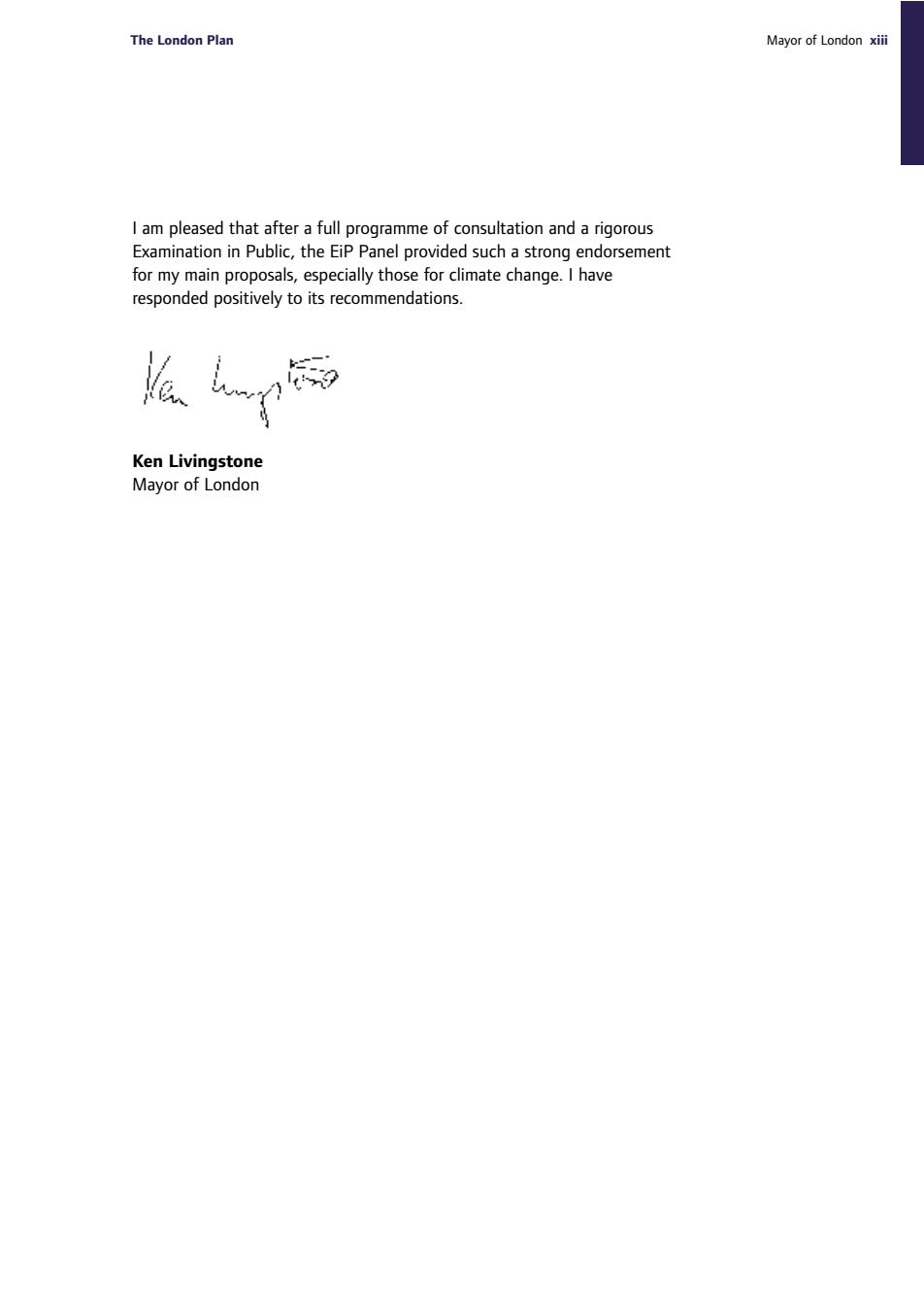
The London Plan Mayor of London xi for my main proposals,especially those for climate change.I have responded positively to its recommendations
The London Plan Mayor of London xiii I am pleased that after a full programme of consultation and a rigorous Examination in Public, the EiP Panel provided such a strong endorsement for my main proposals, especially those for climate change. I have responded positively to its recommendations. Ken Livingstone Mayor of London